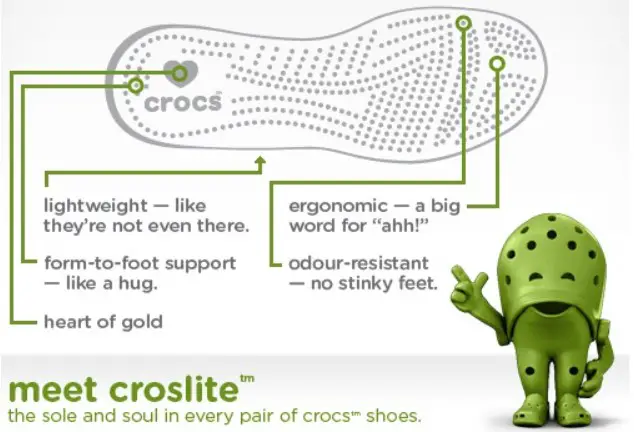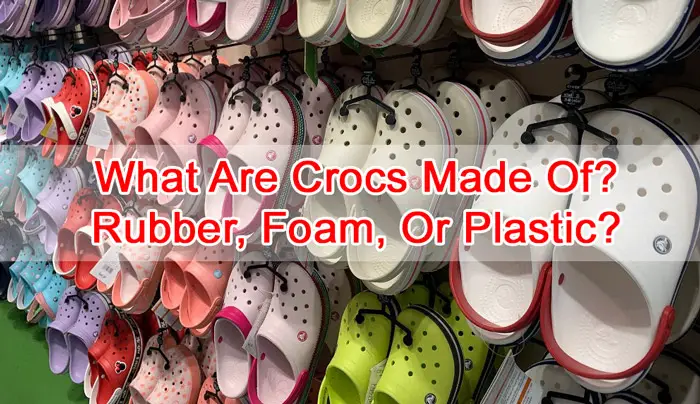Blog
What Are Crocs Made Of? Rubber, Foam, Or Plastic?
Crocs incredibly noticed a sales growth of $1.4 billion in 2020, which is 12.6% higher than the earnings of 2019. If you haven’t owned a pair of Crocs before, you might ask some questions like “What are Crocs made of?”, “Are they just plastic or rubber shoes?”.
Let’s discover the myth behind the exclusive material that made Crocs among the top 10 non-athletic footwear brands with over 720 million products sold in over 90 countries worldwide.
Contents
- What Are Crocs Made Of?
- How Good Is The Croslite Material?
- 9 Interesting Facts On Crocs
- 1. Crocs Are Not Made From Crocodiles
- 2. Crocs Are Not Recycled
- 3. Crocs’ New Material Is Introduced To Reduce Plastic Footprint
- 4. Crocs Were First Designed As Boating Shoes
- 5. Crocs Are Made For Water
- 6. Crocs Aren’t Biodegradable And They Can’t Be Decomposed
- 7. 13 Holes On Each Pair Aren’t Just For Aesthetics
- 8. Crocs Stink When Getting Wet
- 9. Fake Crocs vs Real Crocs
- Final Words
What Are Crocs Made Of?
Crocs are made of a synthetic fiber called Croslite material. This material, which is trademarked by Crocs. Inc, is a closed-cell foam resin with a special proprietary.
To extend its product manufacturing and own exclusive rights to Croslite, Crocs purchased Foam Creations Company and its manufacturing operation.
Some of the latest updates on Croslite:
In 2018, Crocs. Inc innovated Croslite by creating LiteRide – a new material that is 25% lighter and 40% softer than its predecessor, while still providing excellent support and shock absorption.
Check more: Do Crocs Run Big Or Small?
How Good Is The Croslite Material?
Croslite is not plastic or rubber. It is made of closed-cell resin, or PEVA (or Polyethylene-Vinyl Acetate), a type of polymer made of Crude oil. Croslite is also widely known as extended rubber or foam rubber.
There are some reasons why Croslite is preferable to other normal EVA shoes.

Soft, lightweight, comfortable
Croslite is soft, lightweight, and comfortable while providing added stability to your heel and arch. It can reduce the risk of fatigue in your feet by up to 60% and maintain your comfort from heel to toe.
Thus, Crocs shoes and sandals are widely used by doctors, nurses, and those whose jobs require long hours of walking and standing.
Fungal & Bacterial resistant
Croslite is a great anti-fungal and anti-bacterial material. It lets water dry quicker than normal EVA shoes, thus reducing the growth of annoying odors and bacteria.
Require little maintenance
Crocs need little maintenance. As Croslite is a closed-cell resin, bacteria, and smell can grow on the shoes.
But you can clean your Crocs easily with mild soap and water, and your Crocs will be fresh and clean immediately.
Health-friendly
Croslite is safe for human health. Most shoes and sandals of Crocs meet strict quality outcomes and bring no harmful effects to people.
These shoes were also recommended by the US Ergonomics company in 2015 and were accepted by the American Podiatric Medical Association in 2019.
Therefore, you can use Crocs for your kids or elder people.
Check more: Crocs vs Birkenstocks: Which is Better for Your Feet?
9 Interesting Facts On Crocs

1. Crocs Are Not Made From Crocodiles
Despite its name, Crocs are not made from any part of crocodiles. Crocs Inc also doesn’t make any shoes from those animals.
These shoes are designed to walk on land and sea, so they are named “Crocs” – an abbreviation after the amphibious, multi-environment crocodiles.
2. Crocs Are Not Recycled
Despite its environment-friendly statement, Croslite is not a recycled material. It can’t be recycled like plastic, rubber, and other related materials in footwear production.
So if you throw your old Crocs into the waste bins, the recycling company will exclude them from its recycling process.
3. Crocs’ New Material Is Introduced To Reduce Plastic Footprint
Crocs partnered with Dow Chemical Company to introduce Ecolibrium – a new bio-based material to reduce the plastic footprint on Earth.
Instead of fossil fuel as Croslite, Ecolibrium is a Sweden word for pine tree. This material is made from plant-based raw material, a byproduct of the paper-making production from wood.
This material is aimed at cutting CO2 waste in half by 2030, as stated by this Colorado-based footwear company.
4. Crocs Were First Designed As Boating Shoes
Crocs are inspired by the traditional Dutch clogs and were first designed to be boating shoes for boaters. For this purpose, Crocs have grip-focused soles, made from waterproof materials, that provide foot protection.
Nonetheless, Crocs have flexible heel straps and are easy to wear off and on. This design is easy for busy workers, high seas, or running errands.
5. Crocs Are Made For Water
Crocs are made for water, rain, or wet terrains. Many people use Crocs as water shoes. If they are dirty, you can clean them easily with soapy water.
However, Crocs don’t provide adequate stability for fast-moving water bodies. You can only use them in smaller water streams or a few water crossings.
6. Crocs Aren’t Biodegradable And They Can’t Be Decomposed
Crocs can’t be decomposed or biodegradable. In other words, Crocs are not environment-friendly and can cause harm to the environment.
These footwear products are made of chemicals that contain plastic elements, which are hard to break down into the landfill.
Moreover, due to their lightweights, these foam particles can be carried away by water and end up floating in the sea. These particles can release toxic materials and pollute the water, thus harming aquatic animals.
7. 13 Holes On Each Pair Aren’t Just For Aesthetics
Each pair of Crocs has 13 holes on the shoe’s top. Beyond their aesthetic purpose, the holes on each pair of Crocs have two principal purposes.
- First, they act as ventilation holes to dry out excess water drops and moisture to keep your feet fresh and dry.
- Second, they prevent the growth of annoying odors, mold, or bacteria, especially when worn in hot weather.
For Crocs, these holes provide it a chance to sell Jibbitz – decoration pins or charms for Crocs customers. Jibbitz was started in 2005 by Sheri Schmelzer and her husband, Rich, and was acquired in 2006 by Crocs. Inc for $10 million.
Up till now, Jibbitz charm is a major part of Crocs and allows customers to personalize their Crocs shoes.
8. Crocs Stink When Getting Wet
When getting wet (like walking in the rain, being worn by sweaty feet, or improper storage), Crocs can stink.
The excessive moisture trapped on the shoes makes it hard to breathe and leads to a horrible smell. You can clean the shoes easily with some simple products like baking soda, vinegar, etc.
9. Fake Crocs vs Real Crocs
Due to their popularity, there are fake Crocs with cheaper price tags and lower quality. You can spot fake Crocs with some simple clues:
- The true Crocs have a shiny and accurate Crocs logo on the shoe’s surface, while fake ones have the logo as a sticker only.
- The sole of the authentic Crocs has an engraved logo with good and clear details in the middle with size information. There should be its official website URL here.
- On the product tag, there should be its website along with its factory location written as “boulder, colorado.”.
- Authentic Crocs have clear details on size, model, materials, etc.
- Real Crocs are packed inside a branded plastic bag in white or transparent, not a cardboard package.
Final Words
In sum, Crocs are neither made of rubber nor plastic or foam. They are made of Croslite – a trademarked material that provides excellent comfort and stability for people of all ages, genders, and working environments.
However, Croslite isn’t biodegradable and can’t be considered an eco-friendly material.
We hope that this article has given you a clear answer on what kind of material Crocs are made of and why they have gained their popularity over years of development. If you are wearing Crocs, or you have extra information on this footwear brand, feel free to leave your comments here!

